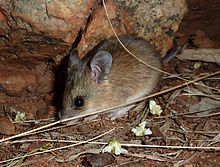Pseudomys
 From Wikipedia the free encyclopedia
From Wikipedia the free encyclopedia
| Pseudomys Temporal range: Late Miocene - Recent | |
|---|---|
 | |
| Sandy inland mouse (Pseudomys hermannsburgensis) | |
| Scientific classification | |
| Domain: | Eukaryota |
| Kingdom: | Animalia |
| Phylum: | Chordata |
| Class: | Mammalia |
| Order: | Rodentia |
| Family: | Muridae |
| Tribe: | Hydromyini |
| Genus: | Pseudomys Gray, 1832 |
| Type species | |
| Pseudomys australis | |
| Species | |
| Pseudomys albocinereus | |
Pseudomys is a genus of rodent that contains a wide variety of mice native to Australia and New Guinea. They are among the few terrestrial placental mammals that colonised Australia without human intervention.
Natural history[edit]
This genus contains a number of species with different habits making generalisation difficult. The overall body size varies widely, ranging from 60 to 160 mm. The tail is 60–180 mm and the weight is recorded from 12 to 90 g. They inhabit a wide variety of habitats from rainforests to plains and grasslands. The animals are nocturnal and spend the day in burrows. Food also varies with some species eating seeds, roots and insects while others feed primarily on grasses. The pebble-mound mice are unique in creating mounds of stones around their burrows. Several species of Pseudomys are threatened due to competition with introduced species and habitat destruction. Several others are probably extinct.
Etymology[edit]
The name Pseudomys means "false mouse"[1] presumably in reference to both its similarity and uniqueness from "true mice" in the genus Mus.
Species[edit]
Genus Pseudomys - Australian native mice
- Ash-grey mouse, Pseudomys albocinereus
- Silky mouse, Pseudomys apodemoides
- Plains rat, Pseudomys australis
- Bolam's mouse, Pseudomys bolami
- Kakadu pebble-mound mouse, Pseudomys calabyi
- Western pebble-mound mouse, Pseudomys chapmani
- Little native mouse, Pseudomys delicatulus
- Desert mouse, Pseudomys desertor
- Smoky mouse, Pseudomys fumeus
- Blue-gray mouse, Pseudomys glaucus †
- Gould's mouse, Pseudomys gouldii[2]
- The Shark Bay mouse was previously described as a separate species Pseudomys fieldi, but is now considered conspecific with P. gouldii
- Eastern chestnut mouse, Pseudomys gracilicaudatus
- Sandy inland mouse, Pseudomys hermannsburgensis
- Long-tailed mouse, Pseudomys higginsi
- Central pebble-mound mouse, Pseudomys johnsoni
- The Kimberley mouse was previously described as a separate species Pseudomys laborifex, but is now considered conspecific with Pseudomys johnsoni
- Western chestnut mouse, Pseudomys nanus
- New Holland mouse, Pseudomys novaehollandiae
- Western mouse, Pseudomys occidentalis
- Hastings River mouse, Pseudomys oralis
- Country mouse, Pseudomys patrius
- Pilliga mouse, Pseudomys pilligaensis
- Heath mouse, Pseudomys shortridgei
- Pseudomys vandycki † (Late Pliocene of Australia)
References[edit]
- ^ Long, J.A.; Archer, M. (2002). Prehistoric Mammals of Australia and New Guinea: One Hundred Million Years of Evolution. UNSW Press. p. 198. ISBN 9780868404356.
- ^ Roycroft, Emily; MacDonald, Anna J.; Moritz, Craig; Moussalli, Adnan; Miguez, Roberto Portela; Rowe, Kevin C. (2021-07-06). "Museum genomics reveals the rapid decline and extinction of Australian rodents since European settlement". Proceedings of the National Academy of Sciences. 118 (27): e2021390118. doi:10.1073/pnas.2021390118. ISSN 0027-8424. PMC 8271571. PMID 34183409.
- Musser, G. G. and M. D. Carleton. 2005. Superfamily Muroidea. pp. 894–1531 in Mammal Species of the World a Taxonomic and Geographic Reference. D. E. Wilson and D. M. Reeder eds. Johns Hopkins University Press, Baltimore.
- Nowak, R. M. 1999. Walker's Mammals of the World, Vol. 2. Johns Hopkins University Press, London.